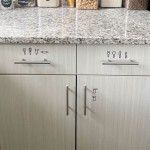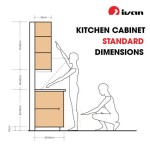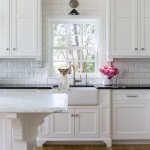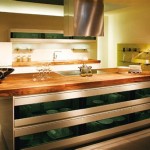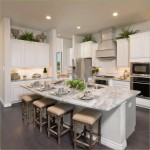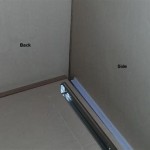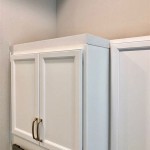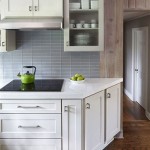Kitchen Cabinets And Countertop Color Combinations: A Comprehensive Guide
Selecting the right color combination for kitchen cabinets and countertops is a crucial aspect of kitchen design. The harmonious integration of these two elements significantly impacts the overall aesthetic appeal and functionality of the space. This article provides a detailed overview of various color combinations, design considerations, and practical tips to assist in creating a visually appealing and functional kitchen.
The kitchen serves as the heart of the home, and its design should reflect both personal style and practical needs. Colors play a vital role in setting the mood and atmosphere of the kitchen. A well-chosen color palette can enhance the space's perceived size, brightness, and welcoming ambiance. Conversely, a poorly planned color scheme can make the kitchen feel cramped, dull, or visually unsettling.
When considering kitchen cabinet and countertop color combinations, it's imperative to understand the basic principles of color theory. Color theory provides a framework for understanding how colors interact with each other, enabling informed decisions regarding color selection and combination. Key concepts include the color wheel, complementary colors, analogous colors, and monochromatic schemes. Understanding these principles will help in creating balanced and visually pleasing combinations.
Understanding Undertones
A critical aspect of selecting color combinations for kitchen cabinets and countertops is understanding undertones. Undertones are the subtle hues that lie beneath the surface color. Identifying the undertones of both the cabinet and countertop materials is essential to ensure a cohesive and harmonious look. Generally, undertones can be categorized as warm, cool, or neutral.
Warm undertones typically consist of reds, yellows, and oranges. Cabinets or countertops with warm undertones often convey a sense of coziness, comfort, and energy. Examples of materials with warm undertones include natural wood finishes with reddish hues, granite with golden veins, and quartz with creamy beige tones.
Cool undertones are characterized by blues, greens, and purples. These undertones often evoke a sense of calmness, serenity, and sophistication. Materials with cool undertones include gray-toned cabinets, white marble countertops with blue-gray veining, and quartz with cool gray bases.
Neutral undertones, as the name suggests, are neither distinctly warm nor cool. They typically consist of shades of white, gray, beige, and greige (a blend of gray and beige). Neutral colors provide a versatile backdrop and can be paired with both warm and cool tones. However, it's important to carefully consider the specific nuances of each neutral shade to ensure compatibility with other elements in the kitchen.
To avoid clashes, it is recommended to pair materials with similar undertones. For instance, cabinets with warm undertones often complement countertops with warm undertones, such as natural wood countertops or granite with golden or reddish hues. Similarly, cabinets with cool undertones pair well with countertops featuring cool undertones, such as white marble or gray quartz.
Popular Color Combinations
Several classic and contemporary color combinations have proven to be successful in kitchen design. The following are some popular options, along with considerations for their implementation:
White Cabinets with Granite Countertops: This combination is a timeless and versatile choice. White cabinets create a bright and airy atmosphere, while granite countertops add visual interest and durability. The specific granite color can vary depending on personal preference and the desired overall aesthetic. For a classic look, consider granite with neutral tones such as gray, beige, or black. For a more dramatic look, consider granite with bolder colors or patterns.
Gray Cabinets with Quartz Countertops: Gray cabinets have gained popularity in recent years, offering a sophisticated and modern alternative to traditional white cabinets. Quartz countertops, known for their durability and low maintenance, pair well with gray cabinets. Choose a quartz color that complements the specific shade of gray used for the cabinets. For example, light gray cabinets can be paired with white or light gray quartz, while dark gray cabinets can be contrasted with white quartz or coordinated with darker gray quartz.
Wood Cabinets with Solid Surface Countertops: Natural wood cabinets offer warmth and character to the kitchen. Solid surface countertops, such as Corian, provide a seamless and hygienic surface that complements wood cabinets. The specific wood species and stain color will influence the choice of countertop color. Lighter wood tones can be paired with light-colored countertops, such as white or cream, while darker wood tones can be contrasted with darker countertops, such as black or dark gray.
Two-Toned Kitchens: Two-toned kitchens involve using different colors for upper and lower cabinets. This can add visual interest and depth to the space. For example, one might choose dark cabinets for the lower units and light cabinets for the upper units, or vice versa. The countertop color should then be selected to complement both cabinet colors and create a cohesive look. Consider using a neutral countertop color that ties the two cabinet colors together.
Colored Cabinets with Neutral Countertops: If bold and vibrant colors are desired for the cabinets, it's generally recommended to pair them with neutral countertops. This approach prevents the kitchen from feeling overwhelming and allows the cabinet color to be the focal point. For instance, blue cabinets can be paired with white or light gray countertops, while green cabinets can be paired with beige or cream countertops.
In addition to these popular combinations, there are countless other possibilities. Experimenting with different colors and materials can result in a unique and personalized kitchen design. However, it's crucial to consider the overall style of the home and the adjacent rooms to ensure a cohesive and harmonious aesthetic.
Practical Considerations and Design Tips
Beyond color theory and popular combinations, several practical considerations and design tips can further enhance the selection process for kitchen cabinet and countertop colors:
Lighting: Lighting plays a crucial role in how colors are perceived. Natural light can significantly impact the appearance of colors, so it is imperative to evaluate the color samples under different lighting conditions. Consider the amount of natural light the kitchen receives and supplement it with artificial lighting, such as LED lights, to ensure accurate color representation. Colors can appear different under warm and cool lighting, so testing samples under different light temperatures is recommended.
Kitchen Size and Layout: The size and layout of the kitchen should also influence color choices. In small kitchens, light colors can help to create a sense of spaciousness and openness. Dark colors can make a small kitchen feel cramped and enclosed. In larger kitchens, darker colors can be used more effectively to create a sense of drama and sophistication. The layout of the kitchen, including the placement of windows and appliances, can also impact color perception and the overall design.
Maintenance and Durability: The practicality of the chosen materials is as important as their aesthetic appeal. Certain countertop materials are more durable and require less maintenance than others. For instance, quartz is known for its stain resistance and low maintenance, while marble requires more frequent sealing and care. Similarly, cabinet finishes vary in their resistance to scratches, stains, and moisture. Consider the lifestyle and cooking habits when selecting materials, prioritizing durability and ease of maintenance for high-traffic areas.
Hardware and Accessories: The choice of hardware, such as cabinet pulls and knobs, and accessories, such as backsplash tiles and lighting fixtures, can significantly impact the overall look of the kitchen. These details should complement the cabinet and countertop colors and contribute to the overall design theme. Consider using hardware in a contrasting metal finish to add visual interest, or choose hardware that blends seamlessly with the cabinet color for a more subtle look. Similarly, select backsplash tiles that complement both the cabinet and countertop colors and add texture and pattern to the space.
Sample Testing: Always test color samples in the actual kitchen environment before making a final decision. This allows observation of how the colors interact with the existing lighting and other elements in the space. Obtain samples of cabinet finishes, countertop materials, and hardware and place them in the kitchen to assess their appearance under different lighting conditions. It is also helpful to take photographs of the samples in the kitchen to compare them side-by-side and get a better sense of how they will look together.
Professional Consultation: If facing difficulties visualizing the final result or uncertain about color choices, consider consulting with a professional kitchen designer or interior decorator. These professionals possess the expertise to guide the selection process and create a cohesive and aesthetically pleasing kitchen design that reflects individual style and preferences. A professional can provide valuable insights into color theory, material selection, and spatial planning, ensuring a successful kitchen renovation or remodeling project.
Careful consideration of these aspects, combined with a thorough understanding of color theory and material properties, will contribute to the creation of a kitchen that is both visually appealing and highly functional. The right color combination can transform the kitchen into a welcoming and enjoyable space for cooking, entertaining, and gathering with family and friends.

How To Choose Color Schemes For Your Kitchen Remodel Kraftmaid

Kitchen Cabinet Color Combinations With Natural Stone Slabs

5 Kitchen Countertop And Cabinet Combinations Academy Marble Ny

Ultimate Guide To Kitchen Color Combinations

What The Trending Kitchen Color Schemes For 2024 Say About Year Ahead Kauffman Kitchens

Popular Kitchen Cabinet Colors Ideas Trends Flooring America

6 Trending Ideas For Kitchen Cabinet Color 2024

9 Kitchen Color Ideas With Incredible Staying Power

Kitchen Cabinet Color Palettes Premium Cabinets

14 Kitchen Cabinet Color Combinations To Try
Related Posts

